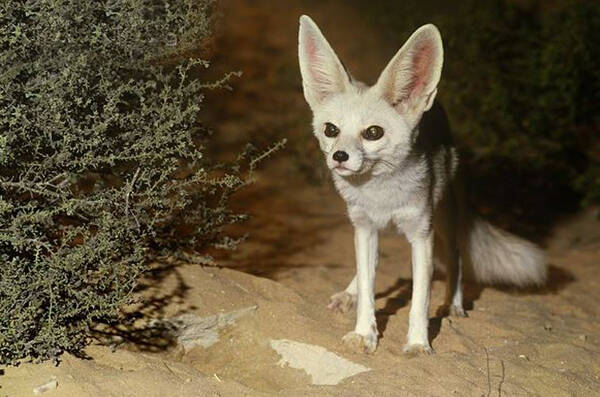Vulpes rueppellii
IUCN
LCBasic Information
Scientific classification
- name:Vulpes rueppellii
- Scientific Name:Vulpes rueppellii,Rüppell's Fox,Lupper fox, Lupper fox
- Outline:Carnivora
- Family:Schizopoda Canidae Vulpes
Vital signs
- length:34-52cm
- Weight:1.1-2.3kg
- lifetime:5-10years
Feature
Usually reddish to gray with a line of black spots from eyes to nose and a white tail tip.
Distribution and Habitat
Distributed in Afghanistan, Algeria, Chad, Djibouti, Egypt, Eritrea, Ethiopia, Islamic Republic of Iran, Iraq, Israel, Jordan, Libya, Mali, Mauritania, Morocco, Niger, Oman, Pakistan, Saudi Arabia, Somalia, Sudan, Syrian Arab Republic, Tunisia, United Arab Emirates, western Sahara, Yemen.
It mainly inhabits arid and semi-arid areas, such as deserts and gravel deserts common in Asia and North Africa, often using natural cracks and caves found in these geological landscapes. It also lives in coastal areas with sparse vegetation and can survive in areas with little water, such as Saudi Arabia.
Appearance
The Corso Vulpes ruficollis is one of the smallest and most elusive members of the fox family. The head and body length of males is 40-52 cm, and females are 34-49 cm; the tail is 29-37 cm long; the ears are 8-11 cm long. Males weigh 1.1-2.3 kg, and females weigh 1.1-1.8 kg. Although much smaller than the red fox, this elegant fox has a similar appearance to the red fox, with ears that are larger than its head. The color of the fur varies depending on the area where it lives, usually reddish to gray, with a row of black spots from the eyes to the nose, and a white tail tip. The legs are slender, and the pads of the feet are covered with soft fur. Unlike other foxes, the Corso Vulpes ruficollis does not dig.
Details
Rüppell's Fox (scientific name: Vulpes rueppellii) is also known as Rüppell's Fox in English. There are 5 subspecies.

Rüppell's Fox is most active at dusk and throughout the night, spending most of its time in caves and crevices. These dens are occupied for an average of 4-5 days before a new den is found. They are omnivorous species, and their diet is a wide variety of rodents, birds, insects, lizards, carrion, and fruit. Although this species often hunts alone, in some areas, it has been shown to be more gregarious in nature and travel in groups.
Corsus rufus have excellent vision and hearing, as well as a well-developed sense of smell, and can use vision and body posture to communicate with their own kind. Because they are social, tactile communication, especially between parents and offspring, and between mates, may also be important. During the breeding season, monogamous pairs are usually formed, and the scent of both sexes marks the territory. Females have a well-developed scent gland that they use to scent-mark dens.
When the male patrols, he sprays urine on the border, but does not leave feces. The scent produced by this species also serves another purpose, and the anal glands provide a defense very similar to that of skunks. When threatened by a predator, they arch their backs and lift their tails, spraying their enemies with special secretions from their anal glands.
Like many desert predators, the Corsus vulpes will eat almost anything that crosses their path. They are omnivores, but are primarily insectivorous, eating insects, small mammals, plant tubers and rhizomes. Corsus vulpes will chase and grab anything they can catch.
Corsus vulpes form monogamous pairs during the mating season. Breeding pairs patrol an area, usually together. Cohabitation of litters does not occur during the non-breeding season. The process of attracting mates is not entirely clear, but Corsus vulpes possess a large number of scent glands. Males and females typically spend a great deal of time scent marking. Males may be able to sense heat through their noses. Corsus vulpes breed during the winter months of November to January. Females give birth to 2-3 pups in March. Pups are born blind. The gestation period is about 50 days, similar to that of red foxes. Pups are fully weaned in 6-8 weeks, independent around 4 months, and reach sexual maturity within the first year. Corso Lewes foxes live about 5-12 years in captivity. Their lifespan in the wild is unknown, but may be significantly reduced due to stress such as predation and competition with red foxes. The maximum lifespan of these foxes in the wild is estimated to be about 6 years.
Corso Lewes foxes are protected by law in Israel, and hunting, trapping, or animal trade is not allowed. In Morocco, Corso Lewes foxes and red foxes can be hunted throughout the year under the annual hunting decree, as they are considered pests. Corso Lewes foxes are bred in captivity at Rabat Zoo in Morocco, Dubai Zoo, and the "Center for the Breeding of Endangered Arabian Wildlife" in Sharjah, United Arab Emirates. Attempts are being made to increase their numbers through breeding programs. Attempts to breed the Corsac vixen are generally not very successful, although they have been successfully bred at the Bar Breeding Center in Eilat, Israel, but overall such efforts have not been very successful. Corsac vixen also occur in some protected areas throughout their range. However, the number of this species in many parts of North Africa remains uncertain.
Listed in the 2015 IUCN Red List of Threatened Species ver 3.1 - Least Concern (LC).
Protect wildlife and eliminate bushmeat.
Maintaining ecological balance is everyone's responsibility!








